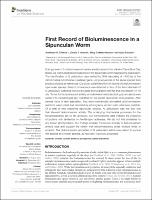Please use this identifier to cite or link to this item:
https://hdl.handle.net/20.500.12202/9627| Title: | First record of bioluminescence in a sipunculan worm |
| Authors: | Oliveira, Anderson G. Amaral, Danilo T. Hannon, Mary Colleen 0000-0003-1752-0726 |
| Keywords: | annelida luciferin luciferase photoprotein marine invertebrate |
| Issue Date: | 2021 |
| Publisher: | Frontiers Media S.A., 2021. |
| Citation: | Oliveira, A. G., Amaral, D. T., Hannon, M. C., & Schulze, A. (2021). First record of bioluminescence in a sipunculan worm. Frontiers in Marine Science, 8. https://doi.org/10.3389/fmars.2021.762706 |
| Series/Report no.: | Frontiers in Marine Science;8 |
| Abstract: | During a search for bioluminescent marine annelids around the island of Carrie Bow Cay, Belize, we discovered bioluminescence in the sipunculan worm Nephasoma pellucidum. The identification of N. pellucidum was verified by DNA barcoding of ∼650 bp of the mitochondrial cytochrome c oxidase I gene, using sequences of the same species from previous studies as references. Our study constitutes the first record of a bioluminescent sipunculan species. Green luminescence was detected in four of the five individuals of N. pellucidum collected from coral rubble from a shallow reef flat and one deeper (14 m) site. To test for bioluminescent activity, all collected annelids (including sipunculans) were sorted into morphotypes and identified to the lowest taxonomic level possible. After several hours of dark adaptation, they were mechanically stimulated, and luminescent reactions were noted and recorded by photography and/or video whenever possible. Of a total of nine examined sipunculan species, N. pellucidum was the only one that showed bioluminescent activity. The underlying biochemical processes for the bioluminescence are so far unknown, but transcriptome data indicate the presence of proteins with similarities to Renilla-type luciferases. We did not find similarities to any known photoproteins. Our findings broaden the known diversity of bioluminescent annelid taxa and support the notion that bioluminescence arose multiple times in annelids. The bioluminescent properties of N. pellucidum add a new reason to pursue this species as a model species, as has been previously proposed. |
| Description: | Scholarly article / Open access [NOTE: The Supplementary Material for this article can be found online at: https://www.frontiersin.org/articles/10.3389/fmars. 2021.762706/full#supplementary-material] |
| URI: | https://doaj.org/article/350b76d0623a44ab9ec74920e35bd2d6 https://hdl.handle.net/20.500.12202/9627 |
| ISSN: | 2296-7745 |
| Appears in Collections: | Stern College for Women -- Faculty Publications |
Files in This Item:
| File | Description | Size | Format | |
|---|---|---|---|---|
| Oliveira OA First record 2021 fmars-08-762706-1.pdf | 429.85 kB | Adobe PDF |  View/Open |
This item is licensed under a Creative Commons License

